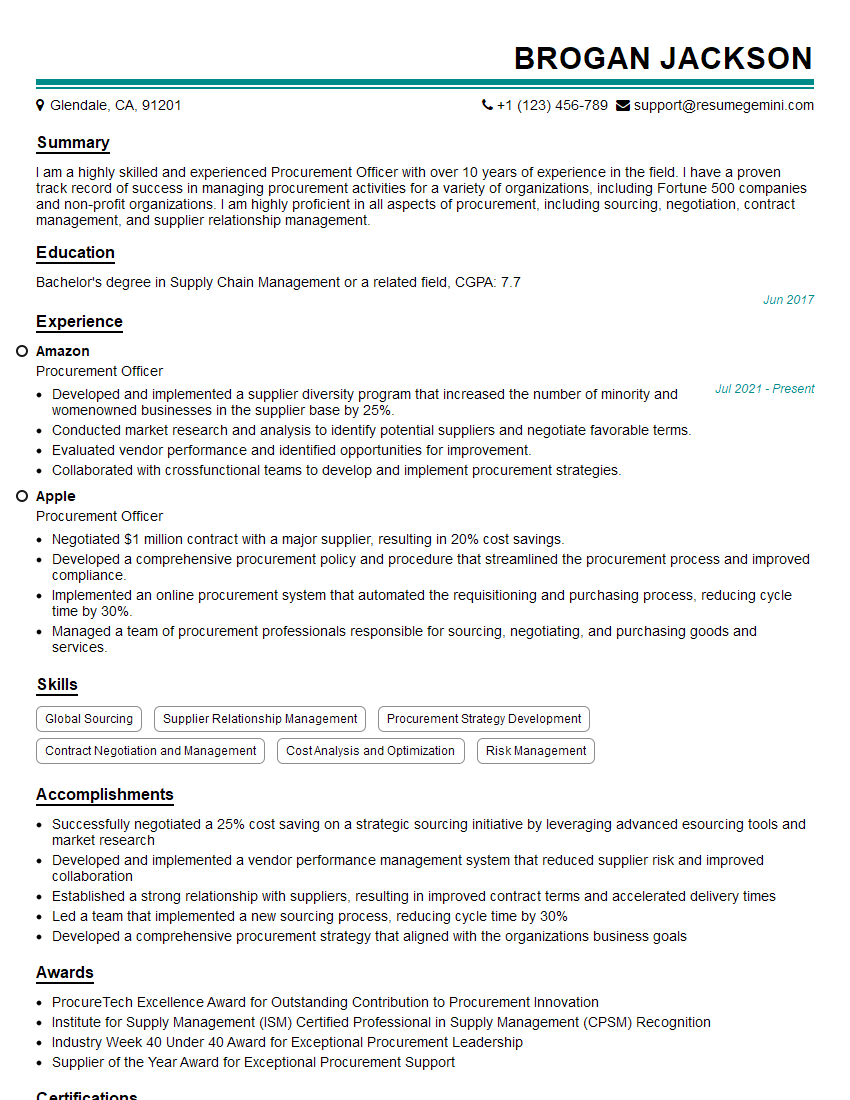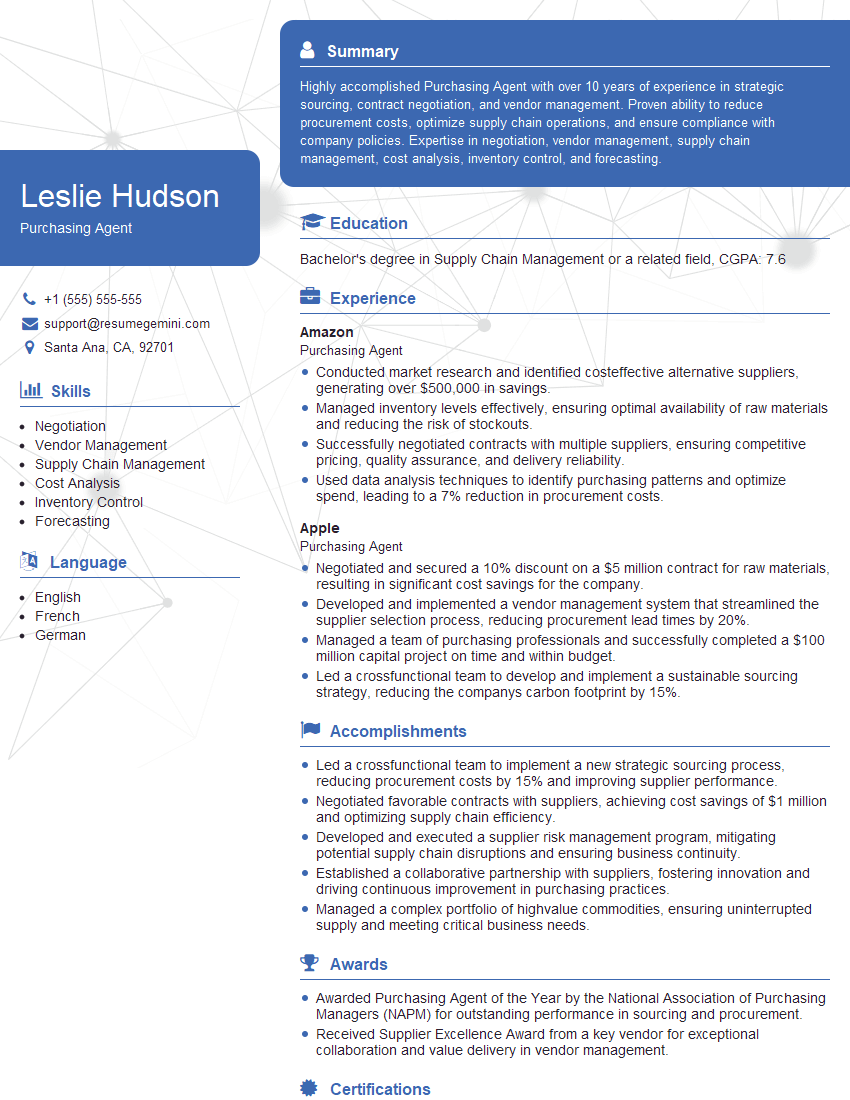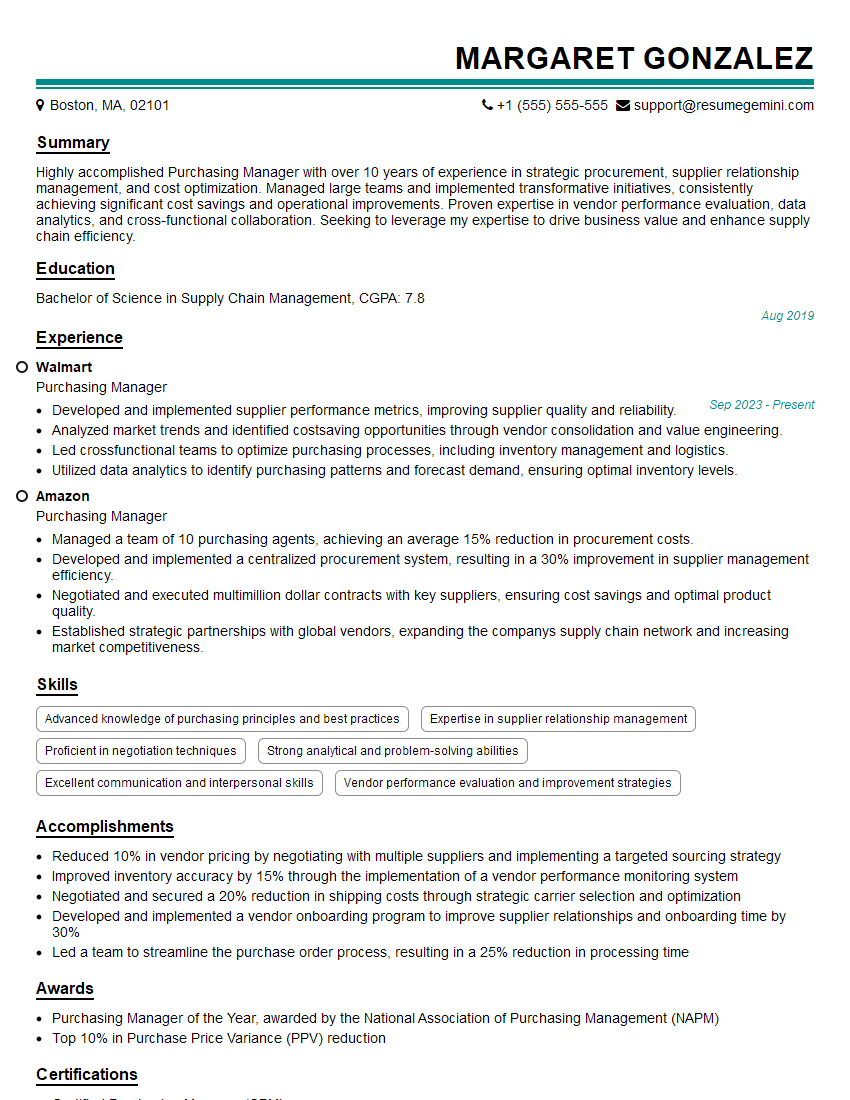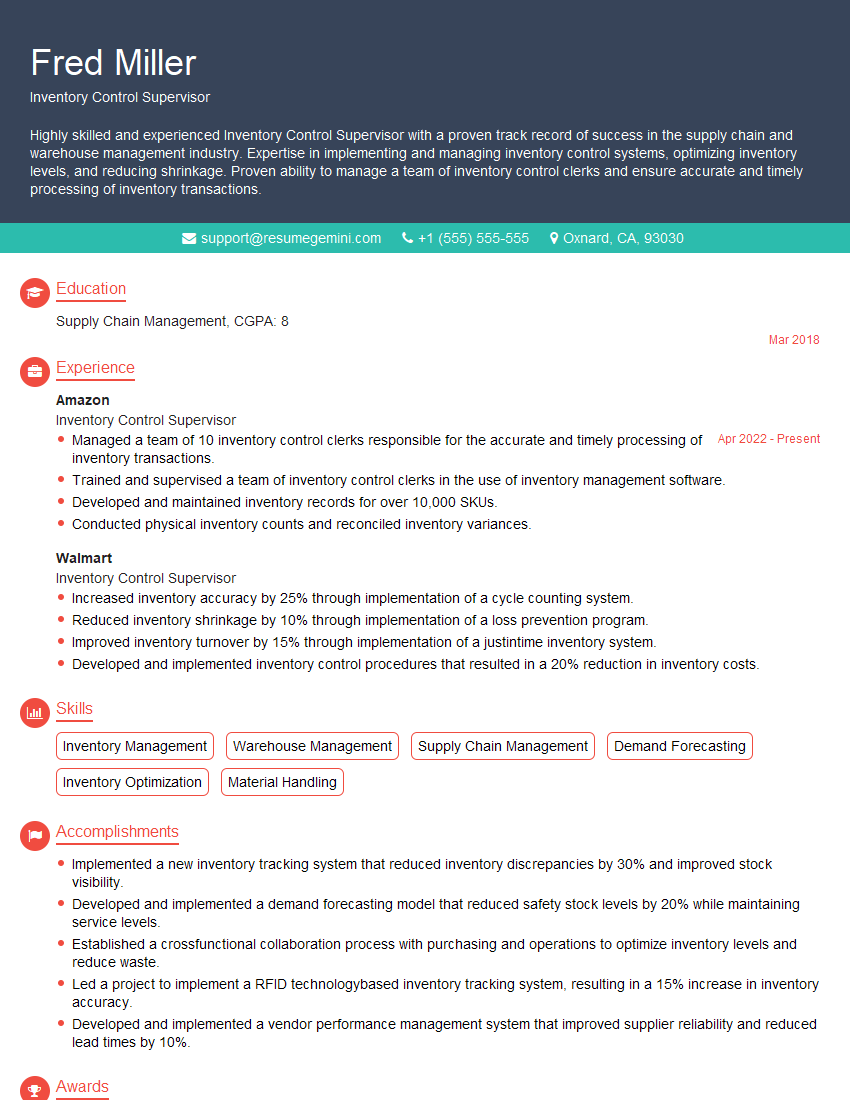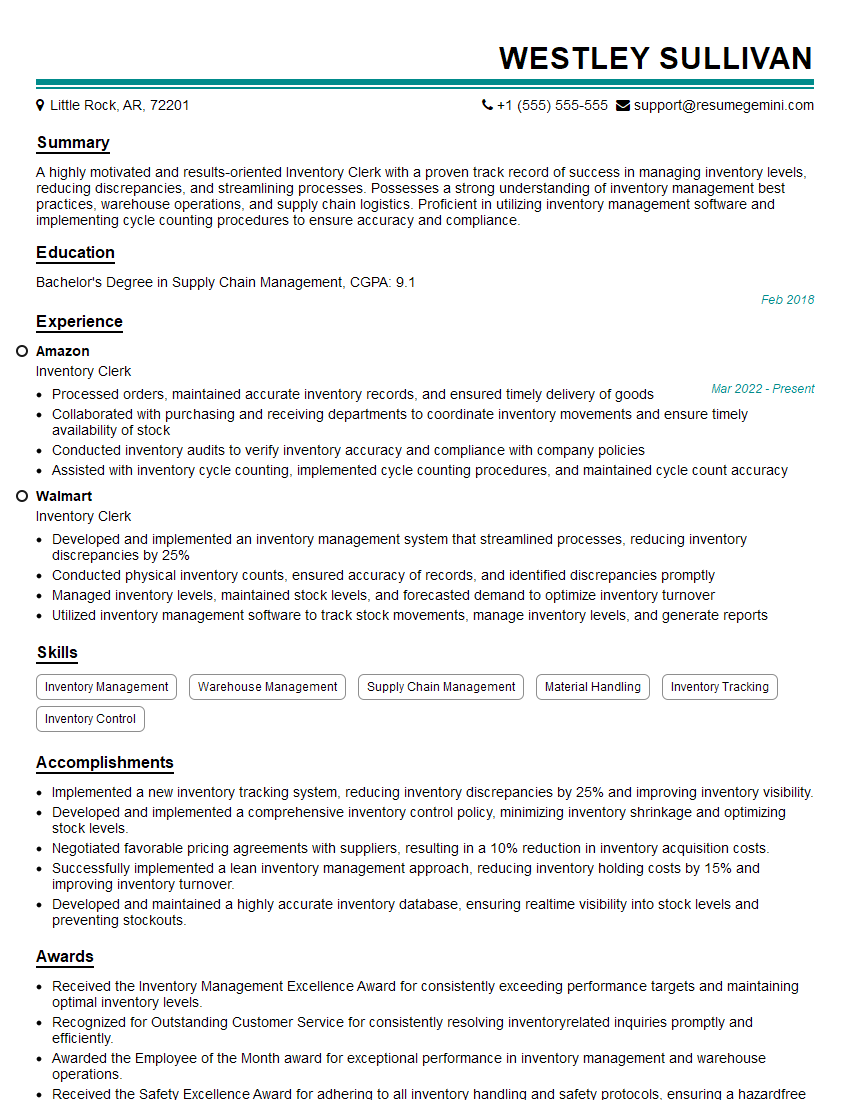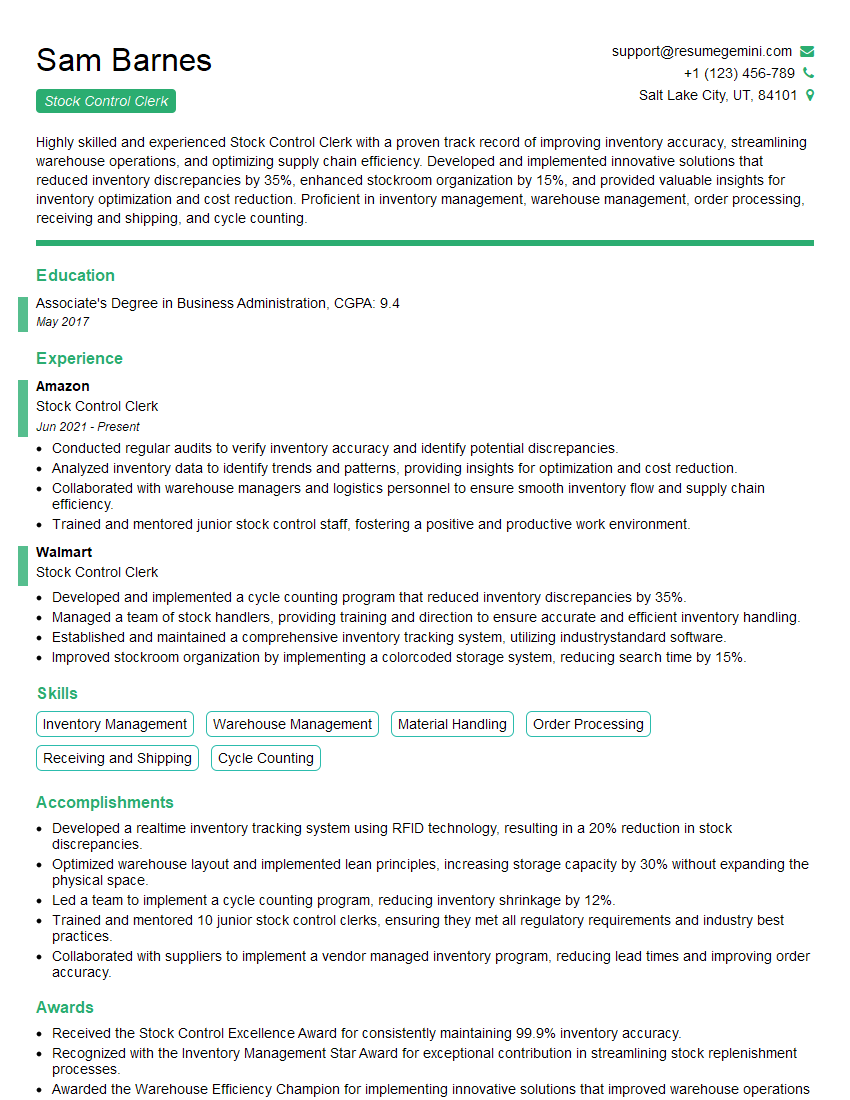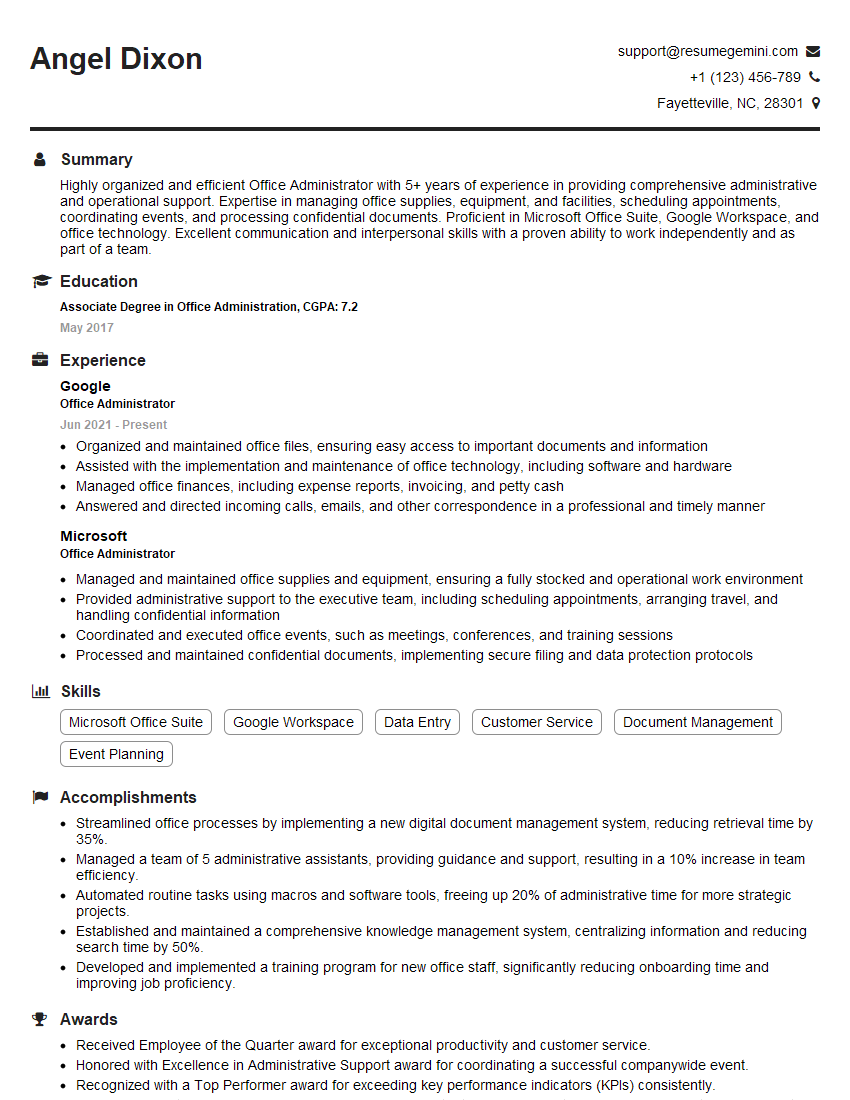Interviews are opportunities to demonstrate your expertise, and this guide is here to help you shine. Explore the essential Office Supply and Inventory Management interview questions that employers frequently ask, paired with strategies for crafting responses that set you apart from the competition.
Questions Asked in Office Supply and Inventory Management Interview
Q 1. Explain your experience with inventory management software.
My experience with inventory management software spans several systems, from basic spreadsheet solutions to sophisticated ERP (Enterprise Resource Planning) systems like SAP and Oracle NetSuite. I’m proficient in using these tools to track inventory levels, manage stock movements, generate reports, and predict future needs. For example, in my previous role at Acme Office Supplies, we implemented NetSuite to replace our outdated spreadsheet system. This resulted in a significant improvement in accuracy, reduced manual data entry errors, and better visibility across the entire supply chain. I’m comfortable with various functionalities including barcode scanning integration, automated reordering, and real-time inventory tracking dashboards.
In a smaller company, I successfully used a simpler system that integrated with our e-commerce platform. This allowed us to automatically update inventory levels based on online sales, preventing stockouts and overstocking. My familiarity extends to data analysis within these systems; I can generate reports on key performance indicators (KPIs) like inventory turnover, carrying costs, and stockout rates to make data-driven decisions.
Q 2. Describe your methods for optimizing inventory levels.
Optimizing inventory levels is a delicate balance between avoiding stockouts and minimizing holding costs. My approach involves employing a combination of techniques, including:
- Demand Forecasting: I use historical sales data, seasonality trends, and market analysis to predict future demand. This might involve using statistical forecasting methods or collaborating with sales teams to get accurate sales projections. For instance, I’d anticipate higher demand for school supplies in August and plan accordingly.
- Economic Order Quantity (EOQ): I leverage EOQ calculations to determine the optimal order quantity that minimizes the total inventory costs, including ordering costs and holding costs. This involves considering factors like ordering costs, storage costs, and the cost of capital.
- Just-in-Time (JIT) Inventory: Where appropriate, I implement JIT inventory management to minimize holding costs by receiving inventory only when needed. This requires strong relationships with reliable suppliers and robust supply chain management.
- ABC Analysis: I categorize inventory items based on their value and demand (A – high value/high demand, B – medium, C – low). This allows me to focus resources on managing the critical A items more closely, ensuring they’re always in stock.
Regularly reviewing and adjusting these strategies based on performance data is key. This iterative process ensures optimized inventory levels throughout the year.
Q 3. How do you handle discrepancies between physical and recorded inventory?
Discrepancies between physical and recorded inventory are inevitable, but addressing them promptly is crucial. My process involves:
- Regular Cycle Counting: Instead of a full annual physical inventory count, I advocate for frequent cycle counts – counting small portions of inventory regularly. This allows for early detection of discrepancies and reduces the impact of large-scale errors.
- Root Cause Analysis: Once a discrepancy is identified, I investigate the root cause. This might involve reviewing picking and packing processes, checking for damaged goods, investigating potential theft, or reviewing the accuracy of the inventory management system itself. For example, a consistent overage in one location might point to an issue with the scanning equipment.
- Corrective Actions: Based on the root cause analysis, I implement corrective actions. This may involve retraining staff, improving inventory tracking procedures, or upgrading the inventory management system.
- Documentation: I meticulously document all discrepancies, their root causes, and the corrective actions taken. This provides a valuable record for continuous improvement and helps prevent similar issues in the future.
Addressing these discrepancies proactively ensures accurate inventory data and supports informed decision-making.
Q 4. What strategies do you use to minimize waste and spoilage?
Minimizing waste and spoilage is paramount, especially with perishable or time-sensitive items. My strategies include:
- First-In, First-Out (FIFO): I strictly adhere to FIFO inventory management, ensuring that older items are used or sold before newer ones. This prevents spoilage and reduces waste significantly. We use clearly labeled shelves and designated storage areas to ensure proper FIFO rotation.
- Proper Storage and Handling: Maintaining appropriate storage conditions for different product types is essential (e.g., temperature control for perishable items, protection from humidity and light). Proper handling procedures also reduce damage and spoilage.
- Regular Stock Rotation: Regular stock checks and rotation help to identify nearing-expiry items and enable timely actions such as discounts or donations to prevent waste.
- Demand Planning and Forecasting: Accurate forecasting minimizes overstocking, which is a primary contributor to waste, especially for products with limited shelf life.
By implementing these practices, we not only save money but also minimize our environmental impact.
Q 5. Explain your experience with vendor management and negotiation.
Vendor management and negotiation are crucial for securing favorable terms and maintaining a reliable supply chain. My approach involves:
- Supplier Relationship Management (SRM): I cultivate strong relationships with key vendors, fostering open communication and collaboration. This allows for early problem-solving and proactive negotiation.
- Strategic Sourcing: I analyze the market to identify reliable suppliers offering competitive pricing, quality, and delivery times. This includes evaluating potential new suppliers and regularly assessing the performance of existing ones.
- Negotiation Strategies: I’m proficient in negotiating contracts, leveraging volume discounts, and exploring alternative payment terms to optimize costs. For example, I might negotiate longer payment terms to improve cash flow or explore bulk discounts for high-volume items.
- Performance Evaluation: I regularly evaluate vendor performance based on key metrics such as on-time delivery, quality of goods, and responsiveness. This allows for timely intervention if performance falls short of expectations.
Building strong vendor relationships results in better pricing, reliable service, and a more stable supply chain.
Q 6. How do you prioritize orders based on urgency and demand?
Prioritizing orders is critical for meeting customer demands and minimizing stockouts. My method considers several factors:
- Urgency: Orders with expedited shipping requirements or critical deadlines are prioritized. This might include orders for essential items or those with short lead times.
- Demand: High-demand items, especially those prone to stockouts, are given precedence. This is particularly important for popular items or those with limited availability.
- Customer Importance: Orders from high-value customers or those with long-standing relationships might receive preferential treatment. This fosters strong customer relationships and loyalty.
- Inventory Levels: Items with low stock levels are prioritized to avoid stockouts and potential lost sales. This requires close monitoring of inventory levels and accurate demand forecasting.
I often use a combination of these factors to create a prioritized order list using a system that allows for flexibility and responsiveness to changing demands. This dynamic approach ensures that the most important orders are always fulfilled first.
Q 7. Describe your process for tracking and analyzing inventory costs.
Tracking and analyzing inventory costs is essential for cost control and profitability. My process involves:
- Cost Categorization: I categorize inventory costs into several components: purchase cost, storage costs (rent, utilities, insurance), handling costs (labor, equipment), obsolescence costs, and shrinkage (theft or damage).
- Inventory Valuation Methods: I’m familiar with different inventory valuation methods (FIFO, LIFO, weighted average cost) and select the most appropriate method based on the specific inventory and accounting requirements.
- Cost Tracking Software: I utilize inventory management software to track costs automatically, reducing manual effort and improving accuracy. This allows for detailed cost analysis at various levels.
- Regular Reporting and Analysis: I generate regular reports on inventory costs, identifying trends and areas for cost reduction. This includes KPIs like inventory turnover, carrying costs, and stockout rates. For example, high carrying costs might indicate an overstocking problem, requiring adjustments to ordering quantities.
This thorough tracking and analysis allows for informed decisions regarding pricing, purchasing, and overall inventory strategy to improve profitability.
Q 8. How familiar are you with different inventory valuation methods (FIFO, LIFO, etc.)?
Inventory valuation methods determine the cost of goods sold and the value of ending inventory. Three common methods are FIFO (First-In, First-Out), LIFO (Last-In, First-Out), and Weighted-Average Cost. FIFO assumes the oldest items are sold first, so the cost of goods sold reflects older purchase prices. LIFO assumes the newest items are sold first, reflecting current market prices in the cost of goods sold. Weighted-average cost calculates an average cost for all inventory items, smoothing out price fluctuations.
FIFO Example: Imagine a stationery store buys 100 pens at $1 each, then 100 more at $1.20. Using FIFO, if they sell 50 pens, the cost of goods sold would be $50 (50 pens x $1/pen). The remaining inventory value would reflect the newer $1.20 cost.
LIFO Example: In the same scenario, using LIFO, the cost of goods sold for 50 pens would be $60 (50 pens x $1.20/pen), as the newer, more expensive pens are assumed sold first. The remaining inventory value would then reflect the older $1 cost.
Weighted-Average Example: The weighted-average cost would be (($1 x 100) + ($1.20 x 100)) / 200 = $1.10 per pen. The cost of goods sold for 50 pens would then be $55.
The choice of method affects financial statements and tax liabilities. FIFO generally results in higher net income during periods of inflation, while LIFO can reduce taxable income.
Q 9. How do you ensure the accuracy of inventory data?
Ensuring accurate inventory data is crucial for efficient operations. This involves a multi-pronged approach combining technology with robust processes.
- Regular Cycle Counting: Instead of a massive annual physical inventory, we implement a cycle counting system, auditing smaller sections of inventory regularly. This minimizes disruption and allows for quicker identification of discrepancies.
- Barcode/RFID Technology: Integrating barcode or RFID scanners into our receiving, stocking, and picking processes provides real-time updates to the inventory system, drastically reducing manual data entry errors.
- Inventory Management Software: We utilize robust software with features like automated alerts for low stock, demand forecasting, and reporting tools to monitor inventory levels accurately. This software should integrate with our point-of-sale (POS) system for seamless data flow.
- Regular Reconciliation: Physical inventory counts are regularly compared to the system’s recorded quantities to identify and correct any discrepancies. This involves investigating root causes for errors and implementing corrective actions.
- Employee Training: Thorough training of employees on proper inventory handling procedures, including accurate scanning and data entry, is essential.
For example, in my previous role, implementing a cycle counting system reduced our inventory discrepancies by 40% within six months.
Q 10. Explain your experience with implementing and maintaining inventory control systems.
My experience with inventory control systems spans several years and different software platforms. I’ve been involved in the full lifecycle—from selection and implementation to ongoing maintenance and optimization. I’m proficient in both cloud-based and on-premise systems.
In one role, I led the implementation of a new inventory management system for a large office supply company. This involved:
- Needs Assessment: Defining the company’s requirements and selecting a system that met those needs, considering factors like scalability, integration with existing systems, and user-friendliness.
- Data Migration: Carefully migrating existing inventory data to the new system, ensuring data integrity and accuracy.
- Training: Developing and delivering comprehensive training programs for staff on using the new system.
- System Configuration: Configuring the system to match our specific business processes and reporting needs.
- Ongoing Maintenance: Regularly monitoring system performance, making necessary updates, and troubleshooting any issues.
The successful implementation resulted in significant improvements in inventory accuracy, reduced stockouts, and streamlined order fulfillment processes.
Q 11. How do you handle stockouts and overstocking situations?
Stockouts and overstocking represent opposite ends of the same problem: inaccurate inventory management. Addressing them requires a proactive approach.
Handling Stockouts:
- Root Cause Analysis: Identify why the stockout occurred—was it due to inaccurate forecasting, unexpected surges in demand, or supplier issues?
- Expedited Ordering: Quickly order more inventory from suppliers, prioritizing critical items.
- Backorder Management: Effectively manage customer backorders, communicating anticipated delivery times and offering alternative solutions if necessary.
- Improved Forecasting: Refine forecasting techniques to better predict demand.
Handling Overstocking:
- Sales Promotions: Implement sales or discounts to move excess inventory.
- Inventory Write-Downs: If necessary, write down the value of obsolete or slow-moving items.
- Return to Supplier: Negotiate with suppliers to return excess inventory if possible.
- Re-evaluation of Purchasing Strategies: Adjust purchasing policies to avoid overstocking in the future.
For example, implementing a robust forecasting model reduced our stockouts by 25% and overstocking by 15% in one of my previous roles.
Q 12. Describe your experience with cycle counting and physical inventory audits.
Cycle counting and physical inventory audits are crucial for maintaining inventory accuracy. Cycle counting involves regularly counting a small portion of the inventory, while a full physical inventory audit is a more comprehensive, periodic process.
Cycle Counting: This is a continuous process, with different sections of inventory counted at scheduled intervals. It allows for quick identification and correction of discrepancies, preventing them from accumulating into larger problems. We often use a pre-defined schedule, such as counting high-value or fast-moving items more frequently.
Physical Inventory Audits: These are typically conducted annually or semi-annually. They involve a complete count of all inventory, comparing the physical count to the inventory system’s records. This process identifies significant discrepancies that may have gone unnoticed through cycle counting.
In my previous role, we successfully combined cycle counting and physical audits, resulting in inventory accuracy exceeding 99.5%.
Q 13. How do you forecast future inventory needs?
Forecasting future inventory needs is critical to avoid stockouts and overstocking. Several methods are used, often in combination.
- Time Series Analysis: This uses historical sales data to predict future demand. Techniques include moving averages, exponential smoothing, and ARIMA modeling.
- Regression Analysis: This identifies relationships between sales and other factors, such as seasonality, promotions, or economic indicators.
- Market Research: Gathering information about market trends and customer preferences can help refine demand forecasts.
- Sales Force Input: Collecting sales forecasts from the sales team provides valuable insights into anticipated demand.
The specific forecasting method chosen depends on data availability, the nature of the products, and the forecasting horizon. I usually combine multiple methods to get a more accurate prediction.
Q 14. What metrics do you use to measure inventory management performance?
Several key metrics measure inventory management performance. These metrics provide insights into efficiency, accuracy, and profitability.
- Inventory Turnover Ratio: Measures how many times inventory is sold and replaced over a period. A higher ratio indicates efficient inventory management.
- Inventory Holding Cost: Represents the cost of storing and managing inventory, including warehousing, insurance, and obsolescence. Lower holding costs are desirable.
- Stockout Rate: The percentage of times an item is out of stock when demanded. A lower rate indicates better forecasting and replenishment.
- Inventory Accuracy: The percentage of inventory items correctly counted and recorded. High accuracy is crucial for reliable decision-making.
- Days Sales of Inventory (DSI): The average number of days it takes to sell inventory. A lower DSI suggests efficient inventory management.
By tracking these metrics, we can identify areas for improvement and optimize our inventory management strategies. Regular reporting and analysis of these metrics are essential to maintain operational efficiency and profitability.
Q 15. How do you identify and resolve supply chain bottlenecks?
Identifying and resolving supply chain bottlenecks requires a systematic approach. Think of a supply chain as a river – if there’s a blockage, the entire flow is affected. My process involves several key steps:
Data Analysis: I start by meticulously analyzing inventory data, order fulfillment times, supplier lead times, and customer demand. This often involves using software to identify trends and patterns. For instance, if we consistently run out of a specific type of printer ink, that indicates a bottleneck in the procurement process.
Bottleneck Identification: Once the data is analyzed, I pinpoint the specific points of congestion. This could be anything from insufficient storage space to slow supplier delivery times, or even internal process inefficiencies like a poorly designed picking system. Perhaps a particular supplier is consistently late, or our internal order processing is slow.
Root Cause Analysis: This is crucial. Simply identifying the bottleneck isn’t enough; I need to understand *why* it exists. Is it due to supplier issues, internal processes, or external factors like transportation delays? For example, a consistently low stock of a particular item might be due to inaccurate demand forecasting.
Solution Implementation: Based on the root cause analysis, I develop and implement solutions. This might involve negotiating better terms with suppliers, optimizing warehouse layout, implementing a new inventory management system, or investing in faster transportation options. If the issue is forecasting, I’d implement a more robust method.
Monitoring and Evaluation: Finally, I continuously monitor the implemented solutions to ensure effectiveness. Key performance indicators (KPIs) are tracked to measure the impact of the changes and make adjustments as needed. Regularly reviewing the KPIs will help prevent the bottleneck from recurring.
Career Expert Tips:
- Ace those interviews! Prepare effectively by reviewing the Top 50 Most Common Interview Questions on ResumeGemini.
- Navigate your job search with confidence! Explore a wide range of Career Tips on ResumeGemini. Learn about common challenges and recommendations to overcome them.
- Craft the perfect resume! Master the Art of Resume Writing with ResumeGemini’s guide. Showcase your unique qualifications and achievements effectively.
- Don’t miss out on holiday savings! Build your dream resume with ResumeGemini’s ATS optimized templates.
Q 16. Describe your experience with using barcode scanners and other inventory tracking technologies.
I have extensive experience with barcode scanners and other inventory tracking technologies. In my previous role, we utilized a comprehensive system integrating barcode scanners, RFID (Radio-Frequency Identification) tags, and a custom-built inventory management software.
Barcode scanners are essential for accurate and efficient inventory tracking. They allow for rapid data entry, minimizing human error and speeding up the stocktaking process. For example, during receiving, scanning each item’s barcode instantly updates the system with its arrival. This eliminates manual data entry and its associated risk of discrepancies.
RFID technology offers even greater efficiency for managing large quantities of items or high-value assets. RFID tags can be read without line-of-sight, enabling faster stock counts and real-time tracking of inventory movement throughout the warehouse. We used RFID tags for high-value items, greatly improving security and reducing the likelihood of loss or theft.
The integrated software provided real-time visibility into inventory levels, allowing us to make data-driven decisions regarding ordering, stock allocation, and potentially identifying slow-moving items requiring promotional efforts.
Q 17. How do you ensure workplace safety in a warehouse or stockroom environment?
Workplace safety is paramount in any warehouse or stockroom environment. My approach is proactive and multi-faceted. It begins with a thorough risk assessment, identifying potential hazards such as heavy lifting, slips, trips, and falls, and fire risks.
Training and Education: All employees receive comprehensive training on safe handling procedures for lifting and moving heavy objects, proper use of equipment (like forklifts), and emergency procedures. Regular refresher training ensures best practices are always top of mind.
Clear Signage and Markings: The warehouse is clearly marked with safety signage, indicating fire exits, emergency equipment locations, and hazard zones. Aisles are kept clear to prevent trips and falls.
Proper Equipment: We ensure all equipment is regularly inspected and maintained, and that employees have access to appropriate personal protective equipment (PPE), such as safety shoes, gloves, and high-visibility vests.
Regular Inspections: Routine inspections are conducted to identify and rectify any potential hazards before they become accidents. This includes checking for damaged flooring, loose objects, and faulty equipment.
Emergency Preparedness: We develop and regularly practice emergency evacuation plans, including fire drills and procedures for handling spills or other incidents. Having a well-rehearsed plan increases efficiency and minimizes panic during emergencies.
By implementing these measures, we create a safe and productive work environment.
Q 18. What is your experience with managing relationships with suppliers?
Managing supplier relationships is crucial for a smooth-running operation. It’s not just about getting the best price; it’s about building long-term partnerships based on trust and mutual benefit. My approach focuses on several key areas:
Strategic Supplier Selection: I carefully vet potential suppliers, evaluating their reliability, financial stability, quality control processes, and their ability to meet our needs consistently. This often involves reviewing their certifications and visiting their facilities to assess their operations.
Clear Communication: Maintaining open and honest communication is key. I ensure that all expectations and requirements are clearly communicated to suppliers, and that feedback is provided regularly. This includes sharing our forecast demands.
Performance Monitoring: I track supplier performance based on key metrics, such as on-time delivery, quality of goods, and responsiveness to issues. This data informs our decision-making regarding future contracts and potential supplier changes.
Collaboration and Negotiation: I strive to build collaborative relationships with suppliers, working together to find solutions to challenges and negotiate mutually beneficial terms. This might involve exploring options for inventory consignment, just-in-time delivery, or volume discounts.
Conflict Resolution: When issues arise, I address them promptly and professionally, working to find amicable solutions that preserve the working relationship. This usually involves open dialogue and a willingness to compromise.
By fostering strong relationships with suppliers, we ensure a reliable supply of high-quality goods at competitive prices.
Q 19. How do you handle returns and damaged goods?
Handling returns and damaged goods requires a well-defined process to minimize losses and maintain customer satisfaction. My approach involves:
Clear Return Policy: A clear and concise return policy is communicated to customers, outlining the procedure for returning goods and the timeframe for processing refunds or replacements. This minimizes confusion and potential disputes.
Inspection and Assessment: Upon receiving returned goods, they are carefully inspected to determine the reason for return (damage, defect, or other). This involves checking for any signs of misuse or damage beyond normal wear and tear.
Disposition of Goods: Depending on the condition of the returned goods, they are either restocked, repaired, or disposed of appropriately. Damaged goods beyond repair might be sold off at a discounted price, or recycled/disposed of responsibly, complying with relevant regulations.
Credit and Refunds: Customers are issued appropriate credit or refunds, in accordance with the return policy. This should be processed promptly and efficiently to maintain goodwill.
Root Cause Analysis: Analyzing the reasons for returns helps us identify potential issues with our products, processes, or supplier quality. This information is used to improve quality control, reduce future returns, and enhance customer satisfaction.
This systematic approach ensures efficient handling of returns while providing valuable insights for process improvement.
Q 20. Describe your experience with budgeting and cost control in relation to inventory.
Budgeting and cost control are crucial aspects of inventory management. I use a variety of techniques to optimize inventory costs while maintaining adequate stock levels:
Demand Forecasting: Accurate demand forecasting minimizes overstocking and reduces the risk of obsolescence and storage costs. I use various forecasting techniques, ranging from simple moving averages to more sophisticated statistical models, depending on the product and data availability.
Inventory Turnover Ratio: I regularly monitor the inventory turnover ratio (cost of goods sold / average inventory), aiming for a healthy turnover rate to minimize storage costs and maximize capital efficiency. A high turnover indicates efficient inventory management.
Economic Order Quantity (EOQ): I utilize the EOQ model to determine the optimal order quantity to minimize total inventory costs, balancing ordering costs and holding costs. This model helps determine the most cost-effective order size.
Just-in-Time (JIT) Inventory: Where feasible, I implement JIT inventory strategies to minimize holding costs by ordering goods only when needed. This requires close collaboration with suppliers and reliable delivery systems.
Inventory Optimization Software: I leverage inventory management software to automate tasks, track inventory levels in real-time, and generate reports that provide insights into inventory costs and performance.
By combining these methods, I ensure that inventory costs are kept in check while maintaining sufficient stock levels to meet customer demand.
Q 21. What are your preferred methods for conducting inventory analysis?
My preferred methods for conducting inventory analysis are both quantitative and qualitative, combining data-driven insights with practical experience:
ABC Analysis: This technique classifies inventory items into categories (A, B, C) based on their value and consumption rate. A items (high value, high consumption) receive more attention and tighter control than B and C items. This prioritizes resources on the most important items.
Inventory Turnover Analysis: As mentioned earlier, analyzing the inventory turnover ratio helps identify slow-moving or obsolete items that need attention. It’s a key indicator of efficiency.
Demand Forecasting Techniques: Utilizing various forecasting methods (e.g., moving average, exponential smoothing, ARIMA models) helps predict future demand, allowing for proactive inventory management and reducing the risk of stockouts or excess inventory.
Visual Management: Regularly reviewing physical inventory levels in conjunction with the software data provides a holistic view. This can expose discrepancies and identify areas for improvement.
Supplier Performance Analysis: Analyzing supplier lead times, quality of goods, and on-time delivery rates is crucial for ensuring a reliable supply chain. Addressing supplier shortcomings prevents future inventory issues.
By employing a multi-faceted approach, I gain a comprehensive understanding of our inventory performance and can identify areas for improvement and cost reduction.
Q 22. How do you ensure compliance with relevant regulations (e.g., OSHA)?
Ensuring OSHA compliance in office supply and inventory management is crucial for maintaining a safe and healthy work environment. This involves understanding and adhering to regulations concerning hazardous materials handling, storage, and disposal. For example, we need to ensure proper ventilation when storing cleaning supplies containing volatile chemicals, use appropriate personal protective equipment (PPE) like gloves and eye protection when handling these materials, and maintain detailed inventory records to track usage and disposal. We’d also implement safety training programs for all staff, covering topics like proper lifting techniques to avoid injuries when moving heavy boxes, and emergency procedures in case of spills or accidents. Regular inspections are essential to proactively identify and address potential hazards. This might involve checking for blocked aisles, damaged containers, or improper storage that could cause accidents.
- Hazard Communication: Implementing a system for clearly labeling and identifying all hazardous materials.
- Emergency Response Plan: Developing and practicing a plan for responding to incidents involving hazardous materials or injuries.
- Regular Inspections: Conducting routine inspections of the warehouse or storage area to identify and correct safety hazards.
Q 23. Describe your experience with using data analytics to improve inventory management.
Data analytics plays a vital role in optimizing inventory management. In my previous role, we used data to analyze sales trends, predict demand, and minimize waste. For instance, we leveraged historical sales data to forecast demand for seasonal items like back-to-school supplies, ensuring we had sufficient stock without overstocking. We also analyzed inventory turnover rates to identify slow-moving items, allowing us to adjust ordering quantities and potentially offer discounts to move excess stock. We used ABC analysis (classifying items based on their value and consumption) to prioritize inventory control efforts on the most valuable items. Further, we integrated data from our point-of-sale (POS) system with our inventory management software to create a real-time view of stock levels and sales data, enabling us to make informed decisions about replenishment and allocation of resources.
For example, by analyzing sales data, we found that sales of a particular type of pen consistently peaked on certain days of the week. This allowed us to optimize our ordering and delivery schedules to ensure we always had sufficient stock on hand during peak demand periods.
Q 24. How do you handle emergencies or unexpected disruptions in the supply chain?
Handling supply chain disruptions requires a proactive and adaptable approach. Having a robust contingency plan is paramount. This plan should include identifying potential risks (like supplier bankruptcy or natural disasters), establishing alternative suppliers, and securing backup logistics solutions. For example, when a major supplier experienced a production delay, we immediately activated our contingency plan by sourcing the needed items from a secondary supplier. This ensured minimal disruption to our operations. Transparency is key; we would communicate promptly with our clients about potential delays. In the case of a warehouse fire, for example, we’d activate the emergency response plan, prioritize the safety of personnel, and then engage in damage assessment, stock recovery (where possible) and communicate with clients about order fulfillment delays. This would be followed by the implementation of temporary warehousing until the affected warehouse could be fully operational again.
Q 25. Explain your experience with different types of inventory (raw materials, work-in-progress, finished goods).
Managing different inventory types requires distinct strategies. Raw materials are the basic components needed for production (e.g., paper, ink, plastic for pens). Their management focuses on ensuring timely availability, minimizing storage costs, and preventing spoilage. Work-in-progress (WIP) represents partially finished products (e.g., assembled pen parts). Efficient WIP management optimizes production flow, reduces bottlenecks, and minimizes waste. Finished goods are completed products ready for sale (e.g., packaged pens). Their management focuses on maintaining adequate stock levels to meet customer demand, preventing obsolescence, and minimizing storage costs. We’d use different tracking methods for each: raw materials might be tracked by weight or volume, WIP by production batch number and finished goods by SKU and location in the warehouse.
Q 26. How do you prioritize tasks and manage time effectively in a fast-paced environment?
In a fast-paced environment, effective task prioritization and time management are crucial. I utilize several techniques: Prioritization matrices (e.g., Eisenhower Matrix – urgent/important) help me focus on high-impact tasks. I break down large projects into smaller, manageable tasks. Time blocking allows for dedicated time slots for specific activities. I also leverage technology; utilizing project management software to track progress, deadlines, and assign responsibilities helps me and my team stay organized and on track. Regular review and adjustments are crucial to adapt to changing priorities. For example, during peak season, I’d prioritize tasks related to order fulfillment and customer service, while during slower periods, I’d focus on projects like inventory optimization or supplier relationship management.
Q 27. How do you adapt to changes in inventory needs or supply chain dynamics?
Adapting to changing inventory needs and supply chain dynamics requires flexibility and a data-driven approach. Continuous monitoring of market trends, customer demand, and supplier performance is crucial. We’d use forecasting techniques to anticipate changes and adjust inventory levels proactively. For example, a sudden increase in demand for a specific product would trigger an immediate adjustment in our ordering process, potentially involving expedited shipping or negotiating with the supplier for quicker delivery. Conversely, a decline in demand would prompt us to reassess inventory levels, potentially offering discounts or promotions to liquidate excess stock. Building strong relationships with suppliers and maintaining a diverse supplier base enhances resilience against disruptions. We’d also be willing to explore new technologies and strategies to improve efficiency and adapt to market changes.
Q 28. Describe your experience with implementing lean principles in inventory management.
Implementing lean principles in inventory management focuses on eliminating waste and optimizing processes. This involves techniques like Just-in-Time (JIT) inventory, which aims to receive materials only when needed to minimize storage costs and reduce waste. We’d also use 5S methodology (Sort, Set in Order, Shine, Standardize, Sustain) to organize the warehouse for better efficiency and reduce search time. Implementing Kanban systems for visual inventory management helps control production flow and prevent overstocking. Value stream mapping allows us to identify bottlenecks and inefficiencies in the inventory process. For example, by implementing Kanban, we moved from a large bulk order system for pens to a smaller, more frequent ordering system based on actual consumption, reducing storage space and preventing stockouts.
Key Topics to Learn for Office Supply and Inventory Management Interview
- Inventory Control Methods: Understanding and applying different inventory management techniques like FIFO, LIFO, and weighted average cost methods. Practical application: Explaining how choosing the right method impacts profitability and reporting accuracy.
- Supply Chain Management Basics: Understanding the flow of goods from supplier to end-user, including procurement, warehousing, and distribution. Practical application: Describing your experience optimizing any part of this process for efficiency and cost reduction.
- Demand Forecasting and Planning: Accurately predicting future demand for office supplies to prevent shortages or overstocking. Practical application: Detailing a scenario where you successfully forecasted demand and managed inventory effectively.
- Inventory Tracking and Management Systems: Proficiency in using inventory management software and systems (e.g., spreadsheets, dedicated inventory management applications). Practical application: Explaining your experience with specific software or systems and highlighting your skills in data entry, reporting, and analysis.
- Procurement and Vendor Management: Negotiating contracts, managing supplier relationships, and ensuring timely delivery of supplies. Practical application: Describing your experience in sourcing supplies, comparing vendor offerings, and managing relationships.
- Cost Control and Budget Management: Monitoring and controlling inventory costs, identifying areas for cost reduction, and adhering to budgetary constraints. Practical application: Providing examples of how you have contributed to cost savings in previous roles.
- Warehouse Management and Organization: Optimizing warehouse space, implementing efficient storage systems, and managing stock rotation. Practical application: Describing your experience with warehouse layout, organization, and stock management strategies.
- Data Analysis and Reporting: Analyzing inventory data to identify trends, make informed decisions, and generate reports for management. Practical application: Explaining how you use data to improve inventory management processes and make recommendations.
Next Steps
Mastering Office Supply and Inventory Management opens doors to exciting career opportunities with increasing responsibility and earning potential. A strong, ATS-friendly resume is crucial for showcasing your skills and experience effectively to potential employers. To build a professional resume that highlights your accomplishments and makes a strong first impression, we recommend using ResumeGemini. ResumeGemini provides a powerful and user-friendly platform for creating compelling resumes, and we offer examples of resumes tailored specifically to Office Supply and Inventory Management to help you get started.
Explore more articles
Users Rating of Our Blogs
Share Your Experience
We value your feedback! Please rate our content and share your thoughts (optional).
What Readers Say About Our Blog
Hi, I’m Jay, we have a few potential clients that are interested in your services, thought you might be a good fit. I’d love to talk about the details, when do you have time to talk?
Best,
Jay
Founder | CEO



